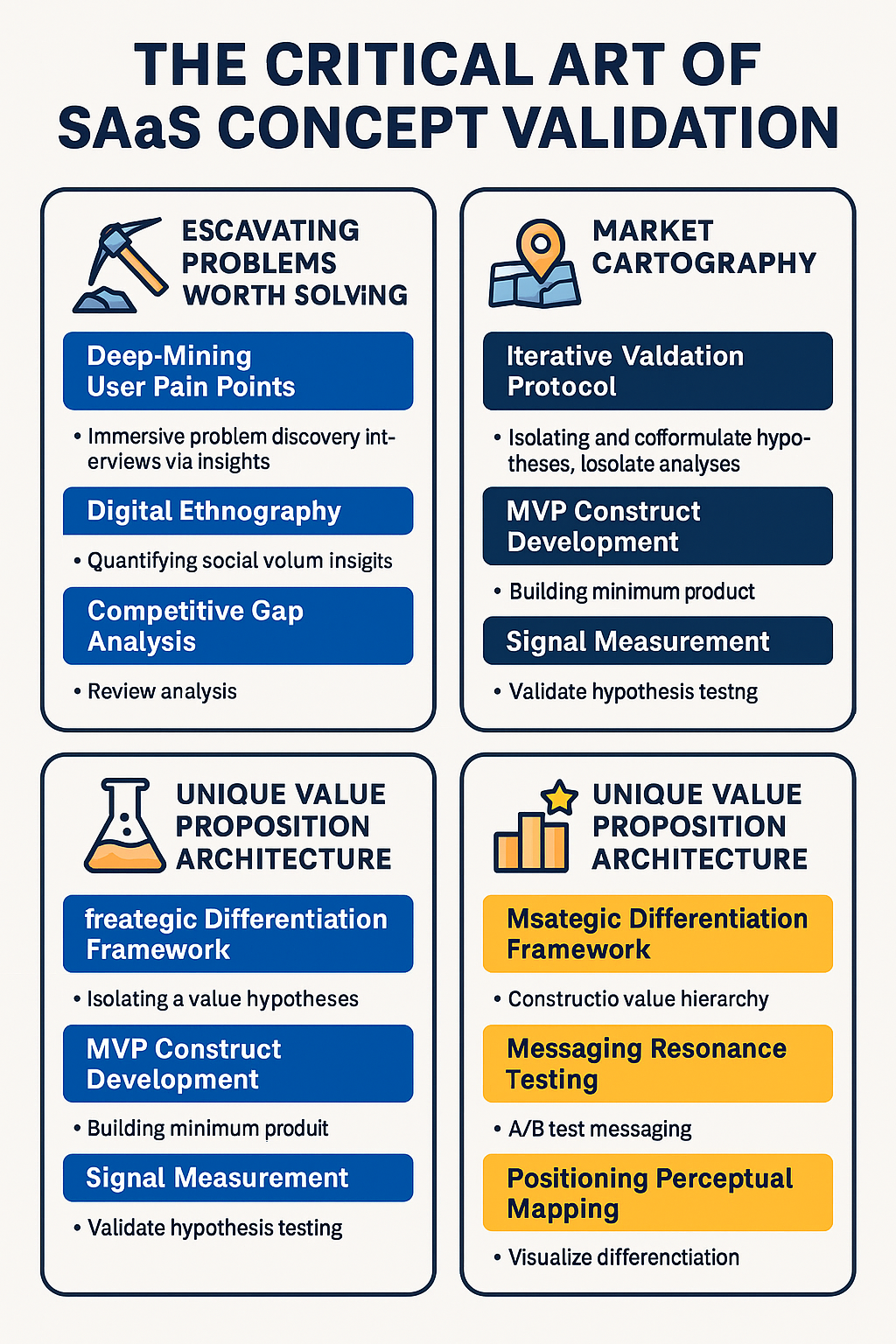
Making Your SaaS Succeed: The Validation Blueprint
Discover the systematic validation framework used by 7-figure SaaS founders to ensure market fit before writing a line of code
From Problem to Profit: The Critical Art of SaaS Concept Validation
In the relentless arena of software-as-a-service, brilliant code alone won't save a misguided concept. I've watched countless ventures collapse under the weight of an unvalidated premise—elegant solutions to problems nobody had. The stark reality? Nearly 42% of startups fail precisely because they build products that markets simply don't want.
Today, I'm pulling back the curtain on the methodology that separates the unicorns from the cautionary tales: systematic SaaS concept validation. This isn't just preliminary research—it's the foundational architecture that either fortifies or fatally undermines everything you'll build.
Excavating Problems Worth Solving
The gold rush of SaaS innovation begins not with solutions, but with problems—specifically, those carrying enough financial and emotional weight to warrant subscription payments.
Deep-Mining User Pain Points:
- Immersive Problem Discovery: Schedule 15-20 customer discovery interviews with target demographic representatives. The magic happens between interviews 8-12, when pattern recognition reveals systemic pain points rather than individual complaints.
- Digital Ethnography: Deploy social listening across specialized digital watering holes—Slack communities, subreddits like r/Entrepreneur, industry Discord servers—where professionals vent authentic frustrations without the performative filter of formal feedback.
- Competitive Gap Analysis: Scrutinize review sections on G2 and Capterra like archaeological sites—the richest insights often hide in four-star reviews where users appreciate a solution but articulate specific unmet needs.
Consider Calendly's origin story: Founder Tope Awotona didn't begin with scheduling software in mind. He began by examining the maddening inefficiency of email ping-pong to schedule meetings—a universal pain point that nonetheless remained unsolved until he recognized its significance.
Market Cartography
Before staking your claim in the SaaS ecosystem, you need precise topographical understanding of the terrain.
Strategic Market Reconnaissance:
- Competitor Matrix Mapping: Create a feature/benefit matrix across direct and adjacent competitors. Track not just functionality, but positioning language, pricing architecture, and customer acquisition channels.
- Demand Signal Verification: Use tools like SEMrush to quantify monthly search volume for problem-related keywords, alongside conversion intent indicators like "problem solution" or "best tool for problem."
- Addressable Market Triangulation: Calculate your serviceable obtainable market (SOM) by identifying the intersection of problem prevalence, willingness to pay, and reasonable customer acquisition costs.
Segment, the customer data platform juggernaut, entered a crowded analytics space but identified its unique territory by methodically mapping gaps between available solutions and emerging customer data complexity—creating a new category rather than competing in an existing one.
The Lean Validation Laboratory
The lean startup methodology isn't just philosophical—it's a structured experimental framework for testing business hypotheses with minimal resource expenditure.
Iterative Validation Protocol:
- Hypothesis Isolation: Formulate specific, falsifiable hypotheses about your customer, problem, and solution. Example: "Marketing managers at B2B SaaS companies spend 5+ hours weekly manually updating cross-channel campaign data."
- MVP Construct Development: Build the minimally viable artifact to test each hypothesis—this might be a landing page, interactive prototype, concierge service, or "Wizard of Oz" backend where you manually deliver what will eventually be automated.
- Signal Measurement: Establish clear validation metrics beyond vanity engagement. For B2B SaaS, consider metrics like problem-solution interview resonance scores, landing page email capture rates, or prototype interaction completion percentages.
Dropbox famously validated its concept not with functioning software, but with a simple explainer video that generated 70,000 signups overnight—confirming massive demand before writing a single line of production code.

Unique Value Proposition Architecture
Your UVP is the cornerstone of market positioning—the distillation of why customers should choose your solution over alternatives, including the status quo.
Strategic Differentiation Framework:
- Value Hierarchy Construction: Map customer priorities by weighting problem aspects according to pain intensity, frequency, and willingness to pay.
- Messaging Resonance Testing: A/B test value proposition language through microtargeted ads or landing page variants to quantify which messaging components trigger highest response.
- Positioning Perceptual Mapping: Plot your solution against competitors on axes that matter most to customers—creating visual representation of your differentiation strategy.
Consider how Notion positioned itself not as "just another note-taking app" but as an "all-in-one workspace"—a subtle but powerful shift that expanded its addressable market while creating category differentiation.
Expert Implementation Framework
Having guided dozens of SaaS ventures through concept validation, I've distilled the process into a structured 21-day validation sprint:
Week 1: Problem Validation
- Days 1-2: Conduct 10+ customer discovery interviews
- Days 3-4: Analyze digital communities for pain point patterns
- Days 5-7: Synthesize findings into problem hypothesis statement
Week 2: Market Validation
- Days 8-10: Complete competitive analysis matrix
- Days 11-12: Assess keyword demand and market sizing
- Days 13-14: Determine monetization potential and unit economics
Week 3: Solution Validation
- Days 15-17: Develop MVP or prototype
- Days 18-19: Conduct solution interviews or tests with target users
- Days 20-21: Analyze results and determine go/no-go decision
This accelerated timeline prevents analysis paralysis while providing sufficient data for informed decisions.
The Validation Imperative
The stakes of validation extend far beyond avoiding wasted development cycles. Properly validated concepts:
- Investor-Ready Evidence - Investors increasingly demand evidence-based validation before committing capital
- Precision Roadmapping - Clear understanding of customer priorities creates natural feature sequencing
- Accelerated Market Entry - Pre-validated messaging shortens time to customer acquisition optimization
- Cross-Team Alignment - Shared understanding of customer pain points aligns engineering, marketing, and sales
The validation process isn't merely preliminary work—it's the foundation that determines structural integrity of everything that follows.
Strategic Next Steps
As you embark on your SaaS validation journey:
- Problems Before Solutions - Rigorously validate pain points before ideating remedies
- Measure Everything - Translate qualitative insights into measurable validation signals
- Embrace Contradiction - Be willing to discard hypotheses that data contradicts, regardless of personal attachment
- Document Rigorously - Create a validation repository that captures all research, becoming your strategic foundation
Tomorrow, we'll build on this foundation by exploring how to architect your minimum viable product and construct a data-informed product roadmap that balances market needs with technical feasibility.
Remember: In SaaS, the winners aren't those with the most features or even the best technology—they're the ones who most precisely match validated market needs with elegant, scalable solutions.
Related Articles

From MVP to Market Domination
Master the technical and strategic architecture decisions that separate scaling SaaS ventures from those that collapse under their own weight

The Customer Acquisition Playbook for Early-Stage SaaS
The low-cost, high-impact acquisition strategies that transformed bootstrapped startups into billion-dollar platforms